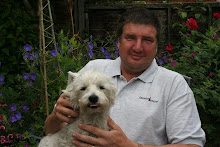 |
| Bull wire. |
We were right to hang onto those worries that the new post and rail fence might not be 100% sheep-proof and a couple of days back I ventured out on some garden errand and spotted that there were only 3 sheep on the lawn. The fourth, one of the rams, was grazing contentedly over by the pond. No damage done; he was quickly rounded up and moved, with his three oppo's, back to the East Field while we investigated the leak. We quickly found hoof prints in some newly dug (daffodil planting) soil - he had shimmied under the bottom rail where a dip in the soil gave him 12 inches or so of space. The solution this time is a single strand of 'bull wire' (it's like smooth trellis wire but thick enough to stop a bull (allegedly)) run along 6 inches from the ground, effectively splitting the bottom gap in half. I had a bit left over from the last job, so I have put that across the bottom two gaps - the taller ones. That seems to have stopped the lamb's gallop and the other three have not tried at all, so possibly I won't need to bull wire the whole 54 metre run.
 |
| Beech nuts - 2014 is a good year. |
Meanwhile, now that we are through the recent list of inbound visits, we are slotting into a nice routine, especially with those sheep. Each morning they get a small breakfast of lamb 'crunch' (it's like meusli for sheep; all manner of grains, molasses-dipped meal etc) but then some more when I lead them round the corner from East Field to the lawn 'entrance' gate. They spend the day grazing the lawn and Primrose Path, browsing the hedges and pulling young ivy from the huge black-spruce trees. Then around 5 pm I rattle another feed bucket (a small amount more 'crunch') and they come sprinting across to be led back to their East Field for over night.
 |
| The very last joint of 2013 lamb - this half leg of Dora. |
In previous years we have used the 'crunch' hard - 1 kg per lamb per day, to try to get good weight on but we are going easy this year. We are happy with the weight gain on honest Roscommon grass and last year's lambs were, if anything, too heavy at slaughter. I will use the crunch this year just for the training, leading them around and so that I get a good look at them a couple of times each day. When a sheep comes sprinting up from the bottom of your East Field to your whistle you can be pretty sure there is not a lot wrong with him!
 |
| The same, roasted. |
By coincidence, we have just used up from the freezer, the last of our lamb joints from 2013, a half leg of the lady we called Dora. The meat has been pure delight. We can't claim organic, or even GM-free because of the crunch, but we can answer for the welfare, love and respect, the complete lack of unnecessary medication once they were here and for the respectful and professionally done 'end' in our local small butchers, Ignatius G in Castlerea. This joint did the original roast on day 1, has done lamb sandwiches for a couple of days for my lunch and my bagel this morning, and has reappeared in a risotto tonight; there is till some left. The dogs enjoyed the bones, too, especially Towser whose turn it was to get the pelvis today.
 |
| Two ladies of a certain age? Min and Squawk |
The birds are mainly through their moult and have come back into lay. We are amused by the fact that the widow, Min (The Hin) our Guinea fowl has paired off with our elderly one remaining Cuckoo Marans hen, 7-8 years old and still laying regularly. This may be because they were both 'bereft' at similar times and are of similar dark colouring, but we see the two of them patrolling about, chattering to each other. The Marans is a genuine 'lady of a certain age', the Guinea fowl just looks like one with her stooped gait and lowered head position.
 |
| Opening the MAQS dose outdoors! |
You'll know from previous posts that we have the expected varroa-mite problem in the hive and needed to apply the 'MAQS' formic acid treatment strips to fume the hive for 7 days. We remember from our pre-hive training days, when one of the group asked a visiting speaker whether MAQS 'seemed toxic enough' and he replied "Sure, there's a hell of a bang off it!" We now know exactly what he meant. The formic acid gel-strips come in sealed sachets in a sealed 'bucket' and the instructions say open it outside. They are so lively they stink from several feet away and the formic acid grabs you by the back of the throat.
 |
| MAQS strips in place on the queen excluder. |
You have to be careful of temperature; you can use the strips when daytime temperatures are between 10 and 29 degrees, but towards the top end you have to create more ventilation or the intense fumes can kill older workers and stop the queen laying. It was about 15 degrees the day we did it, so hopefully we won't have that problem, but the strips are in the hive now slowly doing their stuff, fuming away for 7 days killing mites. The gang will be able to go into the Autumn ivy foraging and Winter, stronger, freed of their parasitic load and will, we hope, survive the winter all the better for that. We take the strips out next Monday when they are spent and we do the mite count thing again in Spring, re-dosing if required.
 |
| Rolo RIP (03-06-2012 to 02-09-2014) |
Sadly, we have a tragedy to report today as one of our lovely cats, Rolo, was killed by a car last night. Mercifully this was instant. The dogs detected the poor little mite lying in the roadside ditch when we were out for our walk; I would never have seen him but for their noses. He's now buried in one of the flower beds, the site marked by a Geranium donated to us by Steak Lady when we were up at a family gathering over the weekend. RIP, old fella. We will miss you - you were a lovely boy as well as a demon mouser and ratter. Your brother Blue will miss you too, and definitely our pup, Poppy, with whom you were best friends. A short but happy and healthy life.










2 comments:
So sorry about Rollo, the house seemed strange without him.
Very sad, he was lovely, RIP rolo
Post a Comment